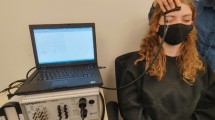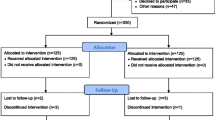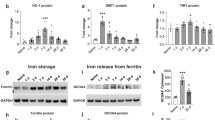Abstract
Background
The coronavirus disease 2019 pandemic has resulted in a growing population of individuals who experience a wide range of persistent symptoms referred to as “long COVID.” Symptoms include neurocognitive impairment and fatigue. Two potential mechanisms could be responsible for these long-term unremitting symptoms: hypercoagulability, which increases the risk of blood vessel occlusion, and an uncontrolled continuous inflammatory response. Currently, no known treatment is available for long COVID. One of the options to reverse hypoxia, reduce neuroinflammation, and induce neuroplasticity is hyperbaric oxygen therapy. In this article, we present the first case report of a previously healthy athletic individual who suffered from long COVID syndrome treated successfully with hyperbaric oxygen therapy.
Case presentation
A previously healthy 55-year-old Caucasian man presented 3 months after severe coronavirus disease 2019 infection with long COVID syndrome. His symptoms included a decline in memory, multitasking abilities, energy, breathing, and physical fitness. After evaluation that included brain perfusion magnetic resonance imaging, diffusion tensor imaging, computerized cognitive tests, and cardiopulmonary test, he was treated with hyperbaric oxygen therapy. Each session included exposure to 90 minutes of 100% oxygen at 2 atmosphere absolute pressure with 5-minute air breaks every 20 minutes for 60 sessions, 5 days per week. Evaluation after completing the treatment showed significant improvements in brain perfusion and microstructure by magnetic resonance imaging and significant improvement in memory with the most dominant effect being on nonverbal memory, executive functions, attention, information procession speed, cognitive flexibility, and multitasking. The improved cognitive functions correlated with the increased cerebral blood flow in brain regions as measured by perfusion magnetic resonance imaging. With regard to physical capacity, there was a 34% increase in the maximum rate of oxygen consumed during exercise and a 44% improvement in forced vital capacity. The improved physical measurements correlated with the regain of his pre-COVID physical capacity.
Conclusions
We report the first case of successfully treated long COVID symptoms with hyperbaric oxygen therapy with improvements in cognition and cardiopulmonary function. The beneficial effects of hyperbaric oxygen shed additional light on the pathophysiology of long COVID. As this is a single case report, further prospective randomized control studies are needed.
Similar content being viewed by others
Background
The coronavirus disease 2019 (COVID-19) pandemic has resulted in a growing population of individuals who experience a wide range of long-lasting symptoms after recovery from the acute illness, referred to by several terms, including “post-COVID conditions” and “long COVID.” The five most common symptoms recognized post-COVID are fatigue (58%), headache (44%), cognitive impairment (27%), hair loss (25%), and dyspnea (24%) [1].
Two main biological sequelae of COVID-19 play roles in the pathogenesis of long COVID. The first is hypercoagulability state characterized by increased risk of small- and large-vessel occlusion [2]. The second is an uncontrolled continuous inflammatory response [3]. Microinfarcts and neuroinflammation are important causes of brain hypoxia and can be responsible for the chronic unremitting neurocognitive decline in patients with long COVID [4]. One of the options to reverse hypoxia, reduce neuroinflammation, and induce neuroplasticity is hyperbaric oxygen therapy (HBOT) [5]. In this article, we present the first case report of previously healthy, athletic individual who suffered from long-standing post-COVID syndrome treated successfully with HBOT.
Case presentation
A 55-year-old previously healthy Caucasian man suffering from persistent unremitting symptoms of long COVID attended our clinic for evaluation. The clinical presentation included memory problems, worsening of multitasking abilities, fatigue, low energy, breathlessness, and reduced physical fitness, which all started after acute SARS-CoV-2 infection diagnosed 3 months before. He initially developed high-grade fever without chest pain, cough, or shortness of breath, on 21 January 2021. He was admitted to hospital because of dehydration on 30 January 2021 and was diagnosed with COVID-19 by reverse-transcription polymerase chain reaction (RT-PCR). During the hospital stay, he developed acute respiratory syndrome due to pneumonitis and required supportive treatment with high-flow oxygen for 1 week. He was discharged from hospital on 16 February 2021. At discharge, he was stable with normal oxygen and no neurological deficiencies were noted on physical examination. In addition, 6 weeks after being diagnosed with COVID-19, he developed a pulmonary embolus and was treated with rivaroxaban. Prior to the SARS-CoV-2 infection, he had been a healthy, high-functioning, and athletic individual.
The baseline evaluation done at our clinic, 3 months after the acute infection, included brain magnetic resonance imaging (MRI) with perfusion and diffusion tensor imaging (DTI), computerized neurocognitive evaluation, cardiopulmonary exercise test (CPET), and pulmonary function tests.
At baseline, the patient complained of shortness of breath with exercise as well as difficulties with memory and multitasking that started after his COVID-19 illness. Physical and neurological examination was normal. Brain MRI evaluation demonstrated reduced perfusion that correlated with the cognitive decline as detailed below. He was referred to hyperbaric oxygen therapy (HBOT) that included 60 sessions, 5 days per week. Each session included exposure to 90 minutes of 100% oxygen at 2 atmosphere absolute with 5-minute air breaks every 20 minutes.
The patient started his first HBOT on 19 April 2021 and finished on 15 July 2021 without any significant side effects. After the first five sessions, he reported that his breathing had started to improve and that he no longer had muscle aches after exercise. After 15 sessions, he noted less fatigue and an improvement in his previous low energy. After 20 sessions, he noticed that his breathing and exercise capacity had returned to his capacity pre-SARS-CoV-2 infection, returning to running mountain trails. Additionally, he noted that his memory and multitasking ability returned to his pre-COVID-19 levels.
The baseline brain MRI, prior to the HBOT, showed two small foci of signal alterations in the right and left parietal regions suggestive of early small-vessel disease. In addition, there was a global decrease in the brain perfusion. As detailed in Fig. 1 and Table 1, re-evaluation after HBOT (done 4 weeks after the last HBOT to avoid any potential intermediate effect) revealed a significant increase in brain perfusion. Tables 2 and 3 present the improvements in the brain microstructure as demonstrated by MRI–DTI.
Brain perfusion magnetic resonance imaging before and after hyperbaric oxygen therapy. The upper row represents brain perfusion 3 months after the acute infection, before hyperbaric oxygen therapy. The lower row represents the perfusion magnetic resonance imaging done after completing the hyperbaric oxygen therapy protocol
Neurocognitive assessment was done using NeuroTrax full computerized testing battery to measure different aspects of brain function, such as memory, information processing speed, attention, and executive function, was done before and after HBOT. The post-HBOT neurocognitive testing showed significant improvement in global memory with the most dominant effect being on nonverbal memory, executive functions, attention, information procession speed, cognitive flexibility, and multitasking. Table 4 summarizes the pre- and post-HBOT scores in the different cognitive domains.
Physical capacity was evaluated by maximal cardiopulmonary exercise test (CPET) conducted on a COSMED treadmill using the Boston 5 protocol. Table 5 presents the pre- and post-HBOT physiological evaluated parameters. As detailed, there was a 34% increase in the VO2 max from 3083 to 4130 mL per minute after HBOT. The forced vital capacity (FVC) improved by 44% from 4.76 to 6.87 L, the forced expiratory volume (FEV) by 23% from 3.87 to 4.76 L, and peak flow measurement (PEF) by 20.2% from 10.17 to 12.22 L per second.
After receiving full information at the end of his post-HBOT evaluation, the patient signed an informed consent allowing publication of his medical information.
Discussion and conclusions
Here, we report the first case of a patient with long COVID with cognitive and cardiorespiratory symptoms treated successfully by HBOT. Following treatment, he showed significant improvements in brain perfusion, white matter brain microstructure, and cognitive and cardiopulmonary function. This case report shows that HBOT has potential use for treatment of patients with long COVID who suffer from unremitting cognitive and physical functional decline.
Hypoxia plays an important role in the pathophysiology of long COVID. Systemic hypoxia could result from lung impairment, and organ-related hypoxia can develop because of vascular damage. Persisting lung function impairment has been seen in patients who required supplemental oxygen during acute SARS-CoV-2 infection even 6 and 12 months after the acute infection [6]. Since brain functionality and regenerative capacity is sensitive to any decline in oxygen supply [7], long-term cognitive deficits correlate with the amount of oxygen needed to overcome the respiratory difficulties [1]. With regard to organ-related ischemia, COVID-19 induced endothelial damage and hypercoagulation, which increases the risk of vascular dysfunction responsible for the high prevalence of myocardial infarction, ischemic strokes, and pulmonary embolism [8]. In the presented case, the patient required supportive treatment with high-flow oxygen for 1 week during the acute illness, meaning he had suffered from systemic hypoxia with its consequent risk for long-term cognitive impairment due to anoxic brain damage. Moreover, 6 weeks after the acute infection, he developed a pulmonary embolus, representative of the endothelial dysfunction with additional exposure to systemic hypoxia. In addition, as demonstrated by the brain perfusion MRI, he had microvascular-related perfusion defects that correlated with his neurocognitive decline.
HBOT involves the inhalation of 100% oxygen at pressures exceeding 1 atmosphere absolute (ATA), thus enhancing the amount of oxygen dissolved in the body tissues. Even though many of the beneficial effects of HBOT can be explained by improvement of tissue oxygenation, it is now understood that the combined action of hyperoxia and hyperbaric pressure triggers both oxygen- and pressure-sensitive genes, resulting in induction of regenerative processes including stem cell proliferation and mobilization with anti-apoptotic and anti-inflammatory factors, angiogenesis, and neurogenesis [9,10,11,12]. HBOT can induce neuroplasticity and improve cognitive function even years after the acute insult [13]. In the case presented of long COVID, HBOT improved cerebral blood flow to the malperfused brain regions (indicative of brain angiogenesis) and improved the integrity of brain microstructure (indicative of neurogenesis). The correlation between the significant improvements demonstrated on brain imaging and the neurocognitive improvements indicates that most of the beneficial effects of HBOT are indeed related to its ability to induce neuroplasticity of the brain’s dysfunctional regions.
HBOT has been demonstrated to have beneficial effects on mitochondrial function, a crucial element of appropriate muscle function [12]. HBOT can also increase the number of proliferating and differentiating satellite cells as well as the number of regenerated muscle fibers, and promote muscle strength [14]. The newly intermittent repeated HBOT protocol was demonstrated to have the potential to improve lung function with respect to peak expiratory flow (PEF) and force vital capacity (FVC) [15]. In the presented patient, performance capacity of the cardiopulmonary system was evaluated using cardiopulmonary exercise test (CPET) and pulmonary function tests. HBOT induced a significant improvement of 34% in the maximal oxygen consumption capacity, an improvement of 34.4% in the maximal METs, and an increase of 16.9% in the lactic threshold. With regard to lung function, FVC was improved by 44.3%, and PEF by 20.2%. These measurable improvements correlated with the patient’s ability to regain his previous high athletic performance.
In this reported case, HBOT was initiated more than 3 months after the acute SARS-CoV-2 infection. Even though the symptoms persisted till the HBOT was initiated and significant improvement began only after HBOT was initiated, it is possible that at least some of the clinical improvement could have occurred without HBOT. However, the abrupt significant improvement with full recovery after the chronic nature of the symptoms, our understanding of the physiological effects of HBOT, and the objective measurements done on this patient support the relation between the treatment and the improvements seen. As this is only a case report, further prospective clinical trials are needed to gain a better understanding of the potential beneficial effects of HBOOT for patients with long COVID.
In summary, this article represents the first case report showing that long COVID can be treated with HBOT. The beneficial effect of HBOT sheds additional light on the pathophysiology of this syndrome. As this is a single case report, further prospective randomized control studies are needed for the use of hyperbaric oxygen therapy in treating long COVID.
Availability of data and materials
All data generated or analyzed during this study are included in this published article.
Abbreviations
- HBOT:
-
Hyperbaric oxygen therapy
- MRI:
-
Magnetic resonance imaging
- DTI:
-
Diffusion tensor imaging
- VO2 max:
-
Maximum rate of oxygen consumed during exercise
- CPET:
-
Cardiopulmonary exercise test
- HR:
-
Heart rate
- Bpm:
-
Heart beats per minute
- FVC:
-
Forced vital capacity
- FEV1 :
-
Forced expiratory volume
- PEF:
-
Peak flow measurement
References
Lopez-Leon S, et al. More than 50 long-term effects of COVID-19: a systematic review and meta-analysis. Sci Rep. 2021;11(1):16144.
Levi M, et al. Coagulation abnormalities and thrombosis in patients with COVID-19. Lancet Haematol. 2020;7(6):e438–40.
Mahmudpour M, et al. COVID-19 cytokine storm: the anger of inflammation. Cytokine. 2020;133: 155151.
Li B, et al. Brain–immune interactions in perinatal hypoxic-ischemic brain injury. Prog Neurobiol. 2017;159:50–68.
Shapira R, et al. Hyperbaric oxygen therapy ameliorates pathophysiology of 3xTg-AD mouse model by attenuating neuroinflammation. Neurobiol Aging. 2018;62:105–19.
Huang L, et al. 1-year outcomes in hospital survivors with COVID-19: a longitudinal cohort study. Lancet. 2021;398(10302):747–58.
Hadanny A, Efrati S. Oxygen—a limiting factor for brain recovery. Crit Care. 2015;19:307.
Katsoularis I, et al. Risk of acute myocardial infarction and ischaemic stroke following COVID-19 in Sweden: a self-controlled case series and matched cohort study. Lancet. 2021;398(10300):599–607.
Pena-Villalobos I, et al. Hyperbaric oxygen increases stem cell proliferation, angiogenesis and wound-healing ability of WJ-MSCs in diabetic mice. Front Physiol. 2018;9:995.
Cabigas BP, et al. Hyperoxic and hyperbaric-induced cardioprotection: role of nitric oxide synthase 3. Cardiovasc Res. 2006;72(1):143–51.
Gregorevic P, Lynch GS, Williams DA. Hyperbaric oxygen modulates antioxidant enzyme activity in rat skeletal muscles. Eur J Appl Physiol. 2001;86(1):24–7.
Zhou Z, et al. Protection of mitochondrial function and improvement in cognitive recovery in rats treated with hyperbaric oxygen following lateral fluid-percussion injury. J Neurosurg. 2007;106(4):687–94.
Hadanny A, et al. Hyperbaric oxygen therapy improves neurocognitive functions of post-stroke patients—a retrospective analysis. Restor Neurol Neurosci. 2020;38(1):93–107.
Horie M, et al. Enhancement of satellite cell differentiation and functional recovery in injured skeletal muscle by hyperbaric oxygen treatment. J Appl Physiol. 2014;116(2):149–55.
Hadanny A, et al. Hyperbaric oxygen therapy effects on pulmonary functions: a prospective cohort study. BMC Pulm Med. 2019;19(1):148.
Acknowledgements
Not applicable.
Funding
No funding was received.
Author information
Authors and Affiliations
Contributions
AMB, ES, SE, and SK analyzed and interpreted the patient data regarding the MRI, perfusion, and DTI. AMB and SE analyzed and interpreted the patient data regarding the cardiopulmonary and pulmonary function tests. All authors read and approved the final manuscript.
Corresponding authors
Ethics declarations
Ethics approval and consent to participate
Not applicable.
Consent for publication
Written informed consent was obtained from the patient for publication of this case report and any accompanying images. A copy of the written consent is available for review by the Editor-in-Chief of this journal.
Competing interests
AMB, ZW, SK, MG, and UQ work for AVIV Clinics. ES works for AVIV Scientific LTD. SE is a co-founder and shareholder at AVIV Scientific LTD.
Additional information
Publisher’s Note
Springer Nature remains neutral with regard to jurisdictional claims in published maps and institutional affiliations.
Rights and permissions
Open Access This article is licensed under a Creative Commons Attribution 4.0 International License, which permits use, sharing, adaptation, distribution and reproduction in any medium or format, as long as you give appropriate credit to the original author(s) and the source, provide a link to the Creative Commons licence, and indicate if changes were made. The images or other third party material in this article are included in the article's Creative Commons licence, unless indicated otherwise in a credit line to the material. If material is not included in the article's Creative Commons licence and your intended use is not permitted by statutory regulation or exceeds the permitted use, you will need to obtain permission directly from the copyright holder. To view a copy of this licence, visit http://creativecommons.org/licenses/by/4.0/. The Creative Commons Public Domain Dedication waiver (http://creativecommons.org/publicdomain/zero/1.0/) applies to the data made available in this article, unless otherwise stated in a credit line to the data.
About this article
Cite this article
Bhaiyat, A.M., Sasson, E., Wang, Z. et al. Hyperbaric oxygen treatment for long coronavirus disease-19: a case report. J Med Case Reports 16, 80 (2022). https://doi.org/10.1186/s13256-022-03287-w
Received:
Accepted:
Published:
DOI: https://doi.org/10.1186/s13256-022-03287-w





